Potential for Sustainable Development in the Southeastern Spanish Region of Guadix
Abstract
1. Introduction
2. Materials and Methods
3. Results
3.1. Statistical and Theoretical Diagnosis of a Problematic Socioeconomic and Demographic Situation
“Stigmatization is the root cause of the consolidation of peripheralization. The perception of a given region by its inhabitants and by external stakeholders (e.g., national politicians [and] potential investors) does influence location decisions of all sorts: Whether to leave or to stay, whether to (dis-) invest, [and] whether to establish, maintain or abandon services of general interest. In discourses on rural peripheries it is sometimes claimed that the negative consequences of peripheralization are results of a failure of local governments and civil societies. One example is the notion of ‘lost regions’”[29] (p. 263).
3.2. Heterogeneity and Internal Inequalities Present in the Region
- Factor 1. Municipal dimension. This factor refers to the total population, the socioeconomic reality, and the facilities of the municipality. High values correspond to municipalities with more inhabitants, with a greater number of unemployed or stable employment contracts, higher income levels, greater licenses for economic activities, and larger educational facilities.
- Factor 2. Economic–demographic dynamism. The variables to which this factor is related are population density, income from economic activities, and licenses for economic activities per inhabitant. Positive correlations are maintained between these three variables.
- Factor 3. Age structure and family nuclei. The municipalities that have higher scores are those with an older age structure and a higher percentage of foreign inhabitants. They also have a higher number of main family dwellings per 100 inhabitants and, in turn, have a lower percentage of inhabitants under 20 years of age.
- Factor 4. Population growth in relation to health centers and the proportion of temporary workers. High values correspond to municipalities that have experienced high relative population growth, fewer health centers per 100 inhabitants, and fewer temporary agricultural workers.
- Factor 5. Marriage–natality. The municipalities with higher scores are those in which more marriages are formalized and there are more births per 100 inhabitants.
- Factor 6. Relative touristic offer. The municipalities that have higher scores have more hostels and pensions for every 100 inhabitants and consequently more accommodation establishments (See Figure 10).
- (1)
- The first cluster includes Darro, Diezma, Fonelas, Marchal, Peza (La), and Purullena. These six municipalities have negative scores in Factor 3—that is, with regard to their age structure and family nuclei. These scores are due to the fact that the percentages of the old population are lower in these municipalities; however, the proportion of young people under 20 years of age is higher. This means that, in relation to Factor 5, namely, regarding marriage and natality, these municipalities are characterized as having the highest birth rates in the Region (see Figure 10 and Figure 11).
- (2)
- The second cluster gathers 11 municipalities: Aldeire, Dollar, Gor, Gorafe, Huéneja, Jerez del Marquesado, Lanteira, Lugros, Morelábor, Pedro Martínez, and Valle del Zalabí. This cluster, similar to the previous one, stands out as having a greater weight in Factor 3, but, in this case, in the opposite direction to the previous cluster, since its score is positive. This is due to the fact that these municipalities are the oldest in the Region and have the highest percentage of people over 65 years old.
- (3)
- In the third cluster of municipalities, Factor 4 has a strongly negative weight. Given that this factor establishes a relationship between population growth, the number of health centers, and the proportion of temporary workers, this negative value is due to the fact that the municipalities grouped in this cluster have the highest number of temporary workers. Such municipalities are Alicún de Ortega, Dehesas de Guadix, Huélago, and Villanueva de las Torres.
- (4)
- The fourth cluster includes seven municipalities: Albuñán, Alquife, Beas de Guadix, Cogollos de Guadix, Ferreira, Gobernador, and Polícar. It is worth noting the negative weight of the marriage–birth rate factor (−1.27) in this cluster. This is due to the fact that, in such municipalities, the birth rate is low, and few marriages are formalized in them.
- (5)
- The fifth cluster includes only the municipality of Guadix. It is the head city of the region and has the top scores in the municipal dimension factor (highest average value = 5.41), being also the municipality with the largest number of inhabitants and the most development in terms of its facilities. As the administrative and political center of the Region, Guadix has historically enjoyed intense and profitable trade. However, nowadays, despite how well connected it is with Granada capital, Guadix’s trade has ceased to be prosperous. Hence, its low score in the second factor and thus its scarce economic–demographic dynamism is even lower than other municipalities with fewer inhabitants.
- (6)
- The sixth cluster is made up of the municipality of Benalúa, which has a 5.13 score in the second factor, that is, with regard to its economic-demographic dynamism. This score is higher than that of the other municipalities in the Guadix Region. Benalúa stands out for having the highest population density in the Region, within which it also occupies the first position in the number of licenses for business activities per inhabitant and second place in income from business activities per inhabitant, the first position in this regard being the municipality of Guadix. For the aforesaid reasons, Benalúa is key to the socioeconomic revitalization of the whole Region.
- (7)
- Finally, the seventh cluster brings together the two municipalities of La Calahorra and Cortes y Graena, which stand out for their significant touristic capacities. They basically host rural tourism and remain in the lower category in terms of accommodations, such as hostels and pensions. The municipality of Cortes y Graena is one of the Andalusian municipalities with the highest scores in terms of its touristic capacity [42].
4. Potential for Sustainable Development in the Region
5. Final Thoughts and Recommendations
Author Contributions
Funding
Institutional Review Board Statement
Informed Consent Statement
Data Availability Statement
Acknowledgments
Conflicts of Interest
References
- Almeida, M.A. Despovoamento e territórios desiguais: Políticas autárquicas e políticas centrais em tempos de mudança. In Atas da Conferência Instituições, Atitudes e Comportamentos Políticos em Tempos de Mudança; ISCTE-IUL: Lisbon, Portugal, 2017; pp. 61–87. [Google Scholar]
- Van Nimwegen, N.; Van der Erf, R. Europe at the Crossroads: Demographic Challenges and International Migration. J. Ethnic Migr. Stud. 2010, 36, 1359–1379. [Google Scholar] [CrossRef]
- Gómez-Ullat, M.; Rieutort, L.; Kamara, A.; Santos, A.S.; Pirra, A.; Solís Merly, G. Demographic Challenges in Rural Europe and Cases of Resilience Based on Cultural Heritage Management. A Comparative Analysis in Mediterranean Countries Inner Regions. Eur. Countrys. 2020, 12, 408–431. Available online: https://content.sciendo.com/view/journals/euco/12/3/articlep408.xml?language=en (accessed on 14 December 2020). [CrossRef]
- Margaras, V. Demographic Trends in EU Regions; European Parliamentary Research Service (EPRS): Brussels, Belgium, 2019; pp. 1–12. Available online: https://ec.europa.eu/futurium/en/system/files/ged/eprs-briefing-633160-demographic-trends-eu-regions-final.pdf (accessed on 14 December 2020).
- Dubois, A.; Roto, J. Making the Best of Europe’s Sparsely Populated Areas. On Making Geographic Specificity a Driver for Territorial Development in Europe; NORDREGIO Working Paper; 2012; Volume 15, pp. 1–84. Available online: https://www.diva-portal.org/smash/get/diva2:700300/FULLTEXT01.pdf (accessed on 14 December 2020).
- Del Molino Molina, S. La España Vacía. Viaje por un País que Nunca Fue; Turner Noema: Madrid, Spain, 2016; pp. 89–291. [Google Scholar]
- Collantes, F.; Pinilla, V. ¿Lugares que no Importan? La Despoblación de la España Rural Desde 1900 Hasta el Presente. Monografías de Historia Rural; Prensas Universitarias de Zaragoza: Zaragoza, Spain, 2019; pp. 10–270. [Google Scholar]
- Comisionado del Gobierno frente al Reto Demográfico. Diagnóstico Estrategia Nacional Frente al Reto Demográfico. Eje Despoblación; Ministerio de Política Territorial y Función Pública: Madrid, Spain, 2018; pp. 1–33. Available online: https://cutt.ly/sf3qPjW (accessed on 30 September 2020).
- Salas Quintanal, H.; González de la Fuente, I. Nueva ruralidad: Procesos sociolaborales y desagrarización de una sociedad local en México (1980–2010). Gaz. Antropol. 2013, 29. Available online: http://www.gazeta-antropologia.es/?p=4295 (accessed on 29 October 2020).
- Entrena-Duran, F. Deagrarianization, the growth of the food industry and the construction of new ruralities. In Food Production and Eating Habits from Around the World: A Multidisciplinary Approach; Entrena-Duran, F., Ed.; Nova Science Publishers: New York, NY, USA, 2015; pp. 3–27. [Google Scholar]
- Augère-Granier, M.L. Farm Diversification in the EU; European Parliamentary Research Service (EPRS): Brussels, Belgium, 2016; pp. 1–8. Available online: https://www.europarl.europa.eu/RegData/etudes/BRIE/2016/581978/EPRS_BRI(2016)581978_EN.pdf (accessed on 14 December 2020).
- Ibănescu, B.C.; Stoleriu, O.M.; Munteanu, A.; Iațu, C. The Impact of Tourism on Sustainable Development of Rural Areas: Evidence from Romania. Sustainability 2018, 10, 3529. [Google Scholar] [CrossRef]
- Chang, K.; Chien, H.; Cheng, H.; Chen, H. The Impacts of Tourism Development in Rural Indigenous Destinations: An Investigation of the Local Residents’ Perception Using Choice Modeling. Sustainability 2018, 10, 4766. [Google Scholar] [CrossRef]
- The EU Rural Development Policy: Facing the Challenges. European Communities. 2008. Available online: https://enrd.ec.europa.eu/enrd-static/fms/pdf/2067BB37-F930-016B-4338-41FC992B5F58.pdf (accessed on 14 December 2020).
- Entrena-Duran, F.; Álvarez-Lorente, T. Dinámicas sociodemográficas, economía y potencialidades de desarrollo sostenible de la Comarca de Guadix (España). Ambiente Desarro. 2014, 18, 9–21. Available online: http://dx.doi.org/10.11144/Javeriana.AyD18-35.dsep (accessed on 15 December 2020). [CrossRef]
- Vachon, B. Le Développement Local: Théorie et Pratique; Gaëtan Morin: Boucherville, QC, USA, 1993; pp. 10–331. [Google Scholar]
- Zoido, F.; Caravaca, I. Andalucía: Segundo Informe de Desarrollo Territorial; Secretariado de Publicaciones de la Universidad de Sevilla: Sevilla, Spain, 2005; pp. 247–320. [Google Scholar]
- Rodríguez-Martínez, F.; Zoido-Naranjo, F. Desarrollo territorial y evaluación de la diversidad y la desigualdad intrarregional: Una aproximación desde Andalucía. Boletín Asoc. Geógrafos Españoles 2001, 32, 113–125. [Google Scholar]
- Hernández-Sampieri, R.; Fernández-Collado, C.; Baptista Lucio, P. Fundamentos de Metodología de la Investigación; McGraw-Hill: Madrid, Spain, 2007; pp. 23–321. [Google Scholar]
- García-Sanz, B. Apuntes para un libro blanco para el desarrollo rural. In Libro Blanco de la Agricultura y Desarrollo Rural. La Agricultura del Futuro: Un Compromiso de Todos; Ministerio de Agricultura, Pesca y Alimentación: Madrid, Spain, 2002; pp. 1–7. [Google Scholar]
- Informe Trimestral de Coyuntura Laboral de Junio de 2020. Prepared by the So-Called “Argos Observatory”, Belonging to the Andalusian Employment Service (Servicio Andaluz de Empleo, SAE in Spanish). 2020, pp. 1–32. Available online: https://www.comarcadeguadix.com/informe-trimestral-de-coyuntura-laboral/ii-trimestre-2020/ (accessed on 25 September 2020).
- Sorokin, P.A.; Zimmerman, C.C. Principles of Rural-Urban Sociology; Henry Holt: New York, NY, USA, 1929; pp. 55–431. [Google Scholar]
- Boserup, E. Woman's Role in Economic Development; Earthscan: London, UK, 1970; pp. 75–156. [Google Scholar]
- García Sanz, B. La Sociedad Rural Ante el Siglo XXI.; Ministerio de Agricultura, Pesca y Alimentación: Madrid, Spain, 1997; pp. 63–120. [Google Scholar]
- Herrero-Prieto, L.C.; Figueroa Arcila, V.F.; Sanz Lara, J.A. Las disparidades territoriales en Castilla y León: Estudio de la convergencia económica a nivel municipal. Rev. Investig. Económica Soc. Castilla León 2006, 9, 15–170. [Google Scholar]
- Camarero-Rioja, L.A.; Cruz, F.; Gonzalez, M.; Del Pino, A.; Oliva, J.; Sampedro, R. The Rural Population in SPAIN. From Disequilibrium to Social Sustainability; Fundación La Caixa: Barcelona, Spain, 2009; pp. 9–189. [Google Scholar]
- Delgado Viñas, C. Depopulation processes in European Rural Areas: A case study of Cantabria (Spain). Eur. Countrys. 2019, 11, 341–369. [Google Scholar] [CrossRef]
- Vachon, B.; Rodríguez, F.; Pérez, L.; Coallier, F. El Desarrollo Local. Teoría y Práctica: Reintroducir lo Humano en la Lógica de Desarrollo; Ediciones Trea: Gijón, Spain, 2001; pp. 18–255. [Google Scholar]
- Leibert, T.; Golinski, S. Peripheralisation: The missing link in dealing with demographic change? Comp. Popul. Stud. 2016, 41, 255–284. [Google Scholar] [CrossRef]
- Leibert, T.; Montanari, G.; Wiest, K. Rural Peripheralization—Urban Polarization? The Significance of Gendered Mobility in Central Germany. In Understanding Geographies of Polarization and Peripheralization. New Geographies of Europe; Lang, T., Henn, S., Sgibnev, W., Ehrlich, K., Eds.; Palgrave Macmillan: London, UK, 2015; pp. 115–134. [Google Scholar]
- Corbett, M. Rural schooling in mobile modernity: Returning to the places I’ve been. J. Res. Rural Educ. 2009, 24, 1–13. [Google Scholar]
- Dahlström, M. Young women in a male periphery—Experiences from the Scandinavian North. J. Rural Stud. 1996, 12, 259–271. [Google Scholar] [CrossRef]
- Alston, M. You don’t want to be a check-out chick all your life: The out-migration of young people from Australia’s small rural towns. Aust. J. Soc. Issues 2004, 39, 299–313. [Google Scholar] [CrossRef]
- Raugze, I.; Gavin Daly, G.; van Herwijnen, M. Policy Shrinking Rural Regions in Europe Towards Smart and Innovative Approaches to Regional Development Challenges in Depopulating Rural Region. ESPON European Union, October 2017. pp. 1–15. Available online: https://pdfs.semanticscholar.org/2d53/b937954a53b107b1683de3275d6f8c06bc3b.pdf (accessed on 14 December 2020).
- Leibert, T.; Wiest, K. The interplay of gender and migration in Europe’s remote and economically weak rural regions: Introduction to a special issue. J. Rural. Stud. 2016, 43, 261–266. Available online: http://www.sciencedirect.com/science/article/pii/S0743016716000024 (accessed on 16 December 2020). [CrossRef]
- Ní Laoire, C. A matter of life and death? Men, masculinities and staying ‘behind’ in rural Ireland. Sociol. Rural. 2001, 41, 220–236. [Google Scholar] [CrossRef]
- Van Herwijnen, M.; Daly, G.; Iotzov, V. Fighting Rural Depopulation in Southern Europe. ESPON European Union, May 2018. pp. 1–12. Available online: https://www.espon.eu/sites/default/files/attachments/af-espon_spain_02052018-en.pdf (accessed on 16 December 2020).
- Martinez-Fernandez, C.; Naoko, K.; Noya, A.; Weyman, T. Demographic Change and Local Development; OECD Publishing: París, France, 2012; pp. 11–310. Available online: https://www.oecd-ilibrary.org/development/demographic-change-and-local-development_9789264180468-en (accessed on 14 December 2020).
- Tietjen, A.; Jørgensen, G. Translating a Wicked Problem: A strategic planning approach to rural shrinkage in Denmark. Landsc. Urban Plan. 2016, 154, 29–43. [Google Scholar] [CrossRef]
- Hair, J.F.; Gómez Suárez, M.; Cano, D.; Frances Prentice, E. Análisis Multivariante (5ª, reimp ed.); Prentice Hall Iberia: Madrid, Spain, 2008; pp. 53–812. [Google Scholar]
- Pérez López, C. Técnicas Estadísticas Multivariante con SPSS; Garceta: Madrid, Spain, 2009; pp. 42–385. [Google Scholar]
- Cruces, E.; de Haro, J.; Sarrión, M.D. Análisis estadístico de la realidad socioeconómica en Andalucía. Una aproximación a escala municipal. Investig. Reg. J. Reg. Res. 2010, 18, 107–140. [Google Scholar]
- Buller, H.; Wright, S.B. Rural Development: Problems and Practices; Avebury: Aldershot, UK, 1990; pp. 55–258. [Google Scholar]
- Pallagst, K.; Wiechmann, T.; Martinez-Fernandez, C. Shrinking Cities: International Perspectives and Policy Implications; Routledge: London, UK, 2013; pp. 25–318. [Google Scholar]
- Hernández-López, G.M. Diagnóstico Para el Acuerdo por la Sostenibilidad y la Eficiencia Energética de los Municipios del Proyecto. ECEMED. Saigrene Renovables; SL.Diputación de Granada: Granada, Spain, 2012; pp. 1–295. [Google Scholar]
- Halfacree, K.H. Talking about rurality: Social representations of the rural as expressed by residents of six English parishes. J. Rural Stud. 1995, 11, 1–20. [Google Scholar] [CrossRef]
- Entrena-Duran, F. Cambios en la Construcción Social de lo Rural. De la Autarquía a la Globalización; Tecnos: Madrid, Spain, 1998; pp. 1–200. [Google Scholar]
- Roberts, L.; Hall, D. Rural Tourism and Recreation: Principles to Practice; CAB Publishing International: Wallingford, UK, 2001; pp. 1–272. [Google Scholar]
- Consejería de Medio Ambiente y Ordenación del Territorio. Red de Espacios Naturales Protegidos de Andalucía (RENPA); Junta de Andalucía: Sevilla, Spain, 2019; p. 1. Available online: https://n9.cl/3prd (accessed on 26 September 2020).
- Plan de Zona Rural a Revitalizar Comunidad Autónoma de Andalucía: Zona Rural a Revitalizar Hoyas de Guadix y Baza. Programa de Desarrollo Rural Sostenible (2010–2014); Ministerio de Agricultura, Alimentación y Medio Ambiente & Junta de Andalucía: Madrid, Spain, 2010; pp. 1–749. Available online: https://n9.cl/89at (accessed on 26 September 2020).
- Saldaña-García, M. Caracterización Agraria del Territorio de la OCA “Montes Orientales”, Provincia de Granada; Junta de Andalucía: Sevilla, Spain, 2014; pp. 1–34. Available online: https://cutt.ly/ffMbCW6 (accessed on 21 September 2020).
- Willer, H.; Lernoud, J. The World of Organic Agriculture. Statistics & Emerging Trends; Medienhaus Plump: Rheinbreitbach, Germany, 2019; pp. 5–355. Available online: https://cutt.ly/8fMmktD (accessed on 21 September 2020).
- Escribá-Pérez, C.; Rivera-Vilas, L.M. La agricultura ecológica en España: Análisis, tendencias y previsiones. Boletín Económico De ICE Inf. Comer. Española 2004, 2824, 11–26. [Google Scholar]
- Sibello Hernández, R.Y.; Febles González, J.M. Estudio de la erosión de los suelos en áreas protegidas de cienfuegos, utilizando el cesio 137 como radiotrazador. Nucleus 2011, 50, 31–35. [Google Scholar]
- Informe de Infraestructuras Energéticas en GRANADA; Junta de Andalucía: Sevilla, Spain, 2018; pp. 1–22. Available online: https://cutt.ly/YfMQFxo (accessed on 21 September 2020).
- Fajardo García, G.; Escribano Pizarro, J. Despoblamiento y Desarrollo Rural. Propuestas de la Economía Social; CIRIEC-España: Valencia, Spain, 2020; pp. 1–213. [Google Scholar]
- Sánchez-Martínez, J.D.; Rodríguez-Cohard, J.C.; Garrido-Almonacid, A.; Gallego-Simón, V.J. Social Innovation in Rural Areas? The Case of Andalusian Olive Oil Co-Operatives. Sustainability 2020, 12, 19. [Google Scholar] [CrossRef]
- Becattini, G.; Costa Campi, M.T.; Trullén, J. Desarrollo Local: Teorías y Estrategias; Civitas: Madrid, Spain, 2002; pp. 30–339. [Google Scholar]
- Sharpley, R.; Sharpley, J. Rural Tourism: An Introduction; International Thomson Business Press: London, UK, 1997; pp. 42–192. [Google Scholar]
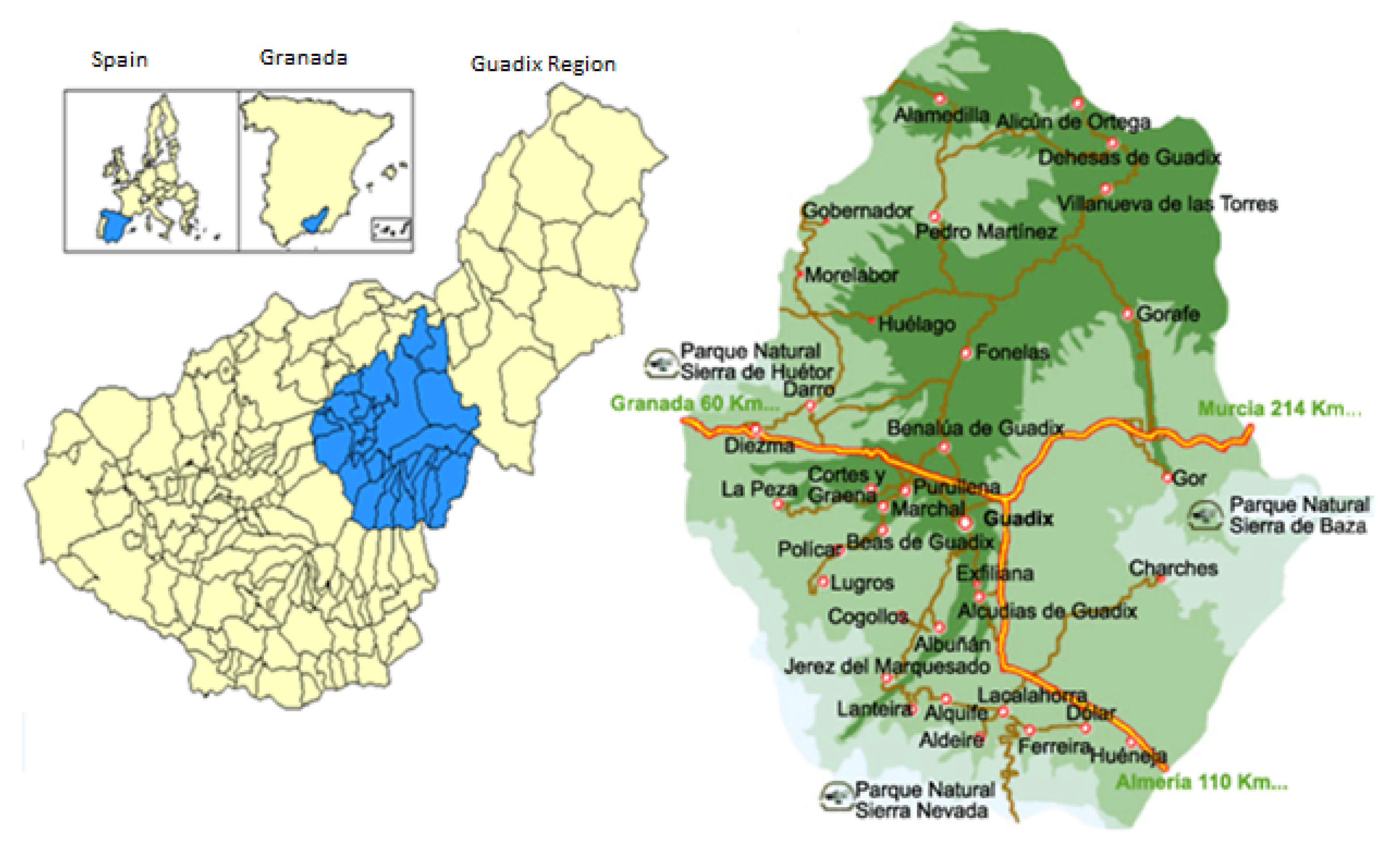
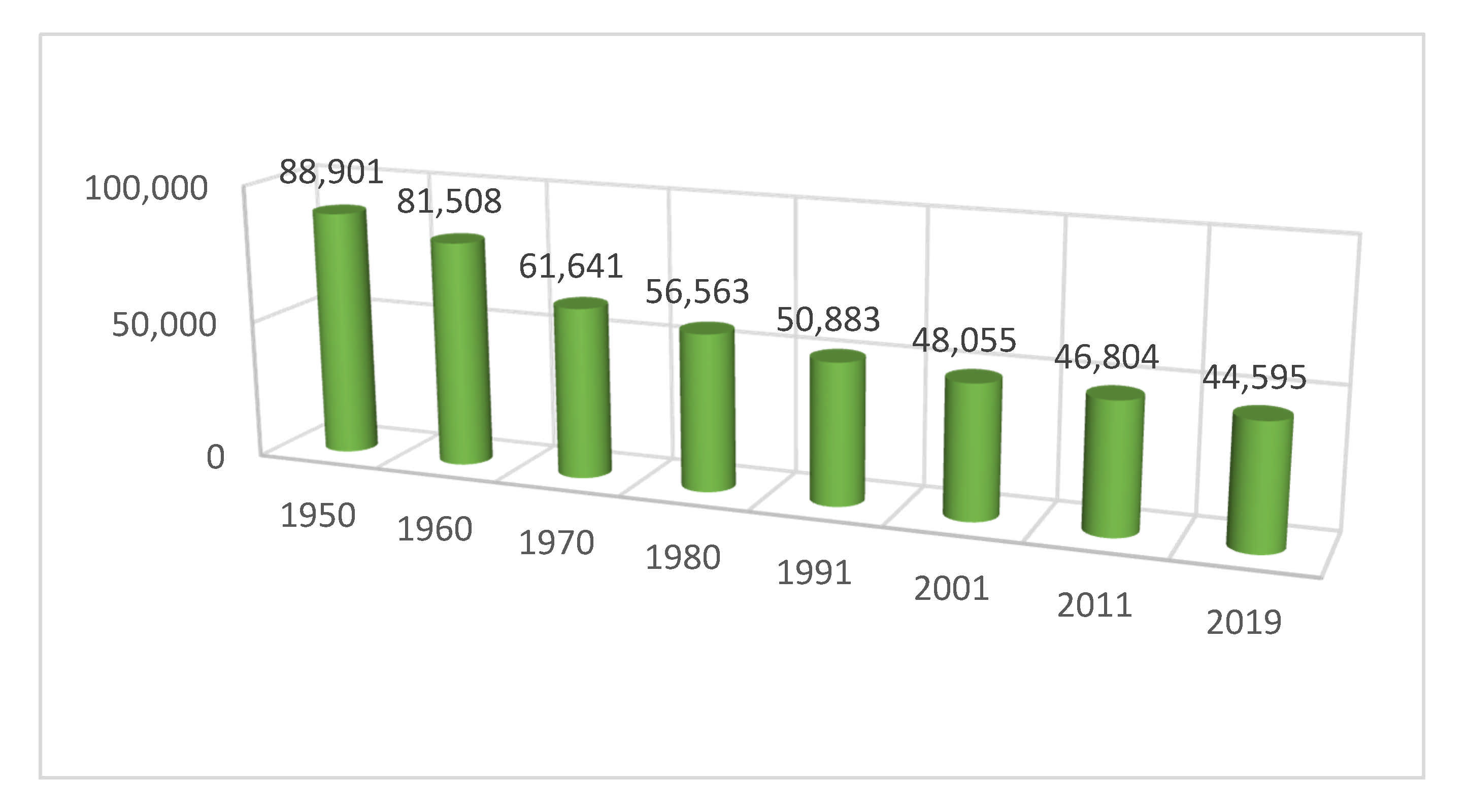
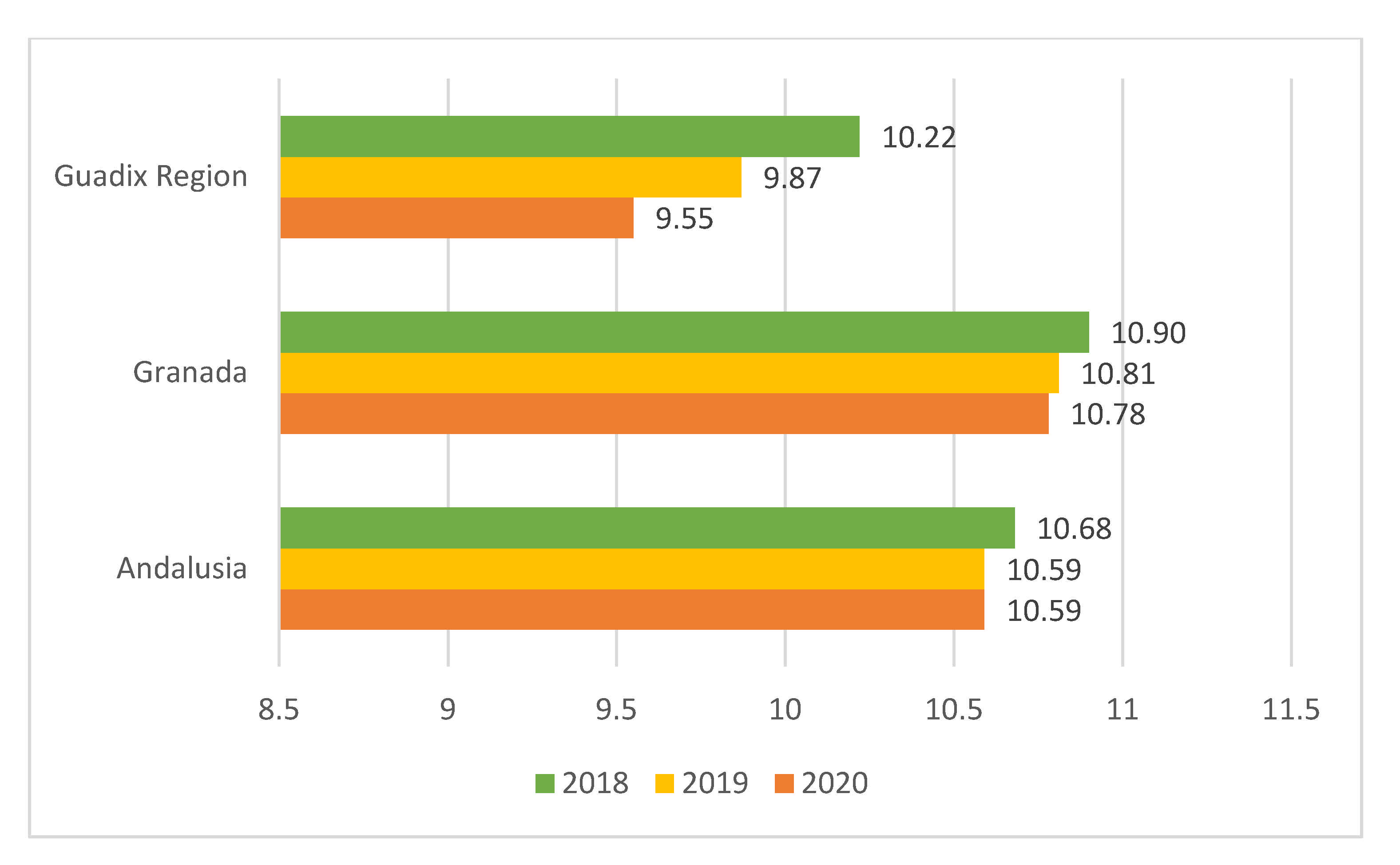
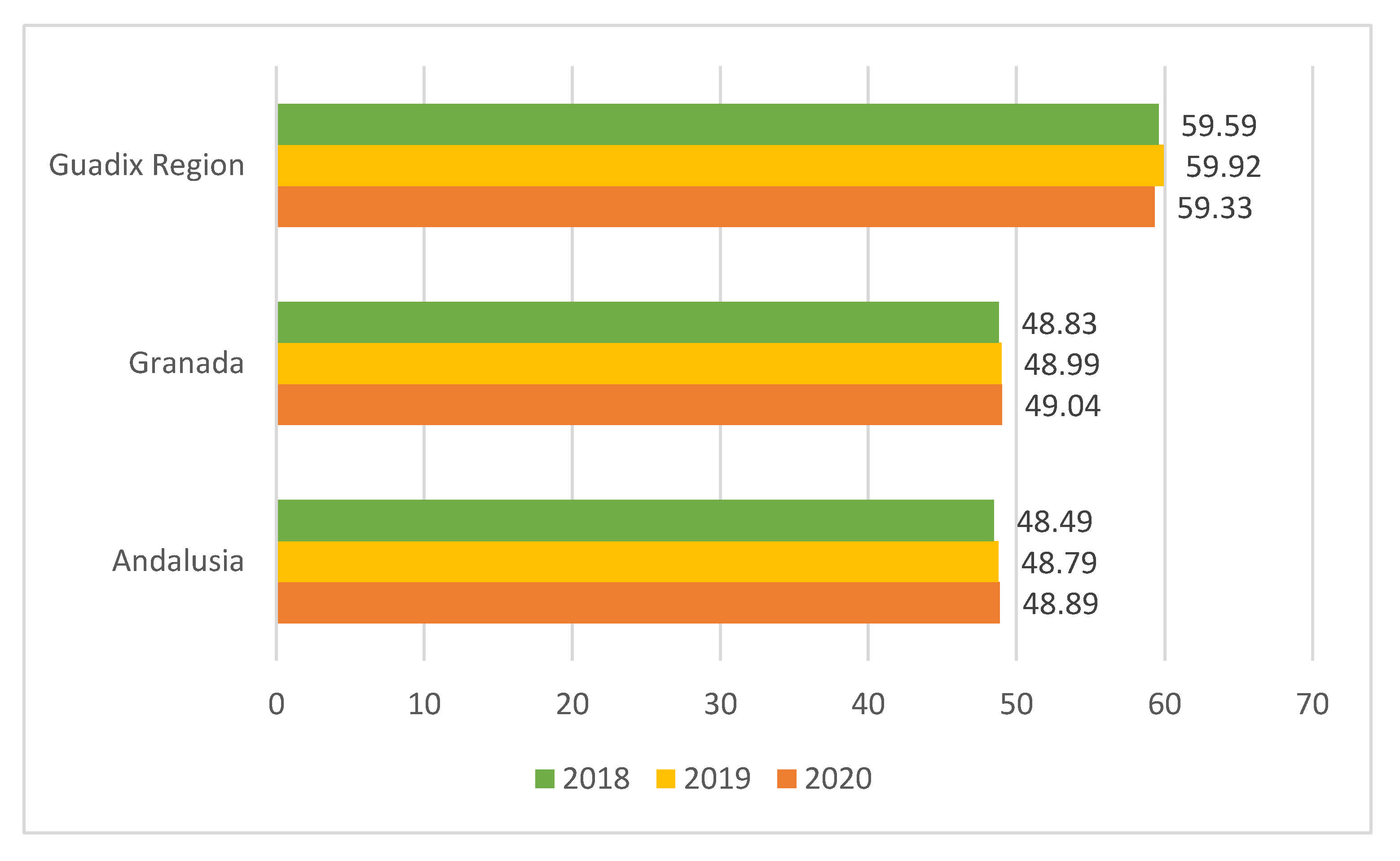
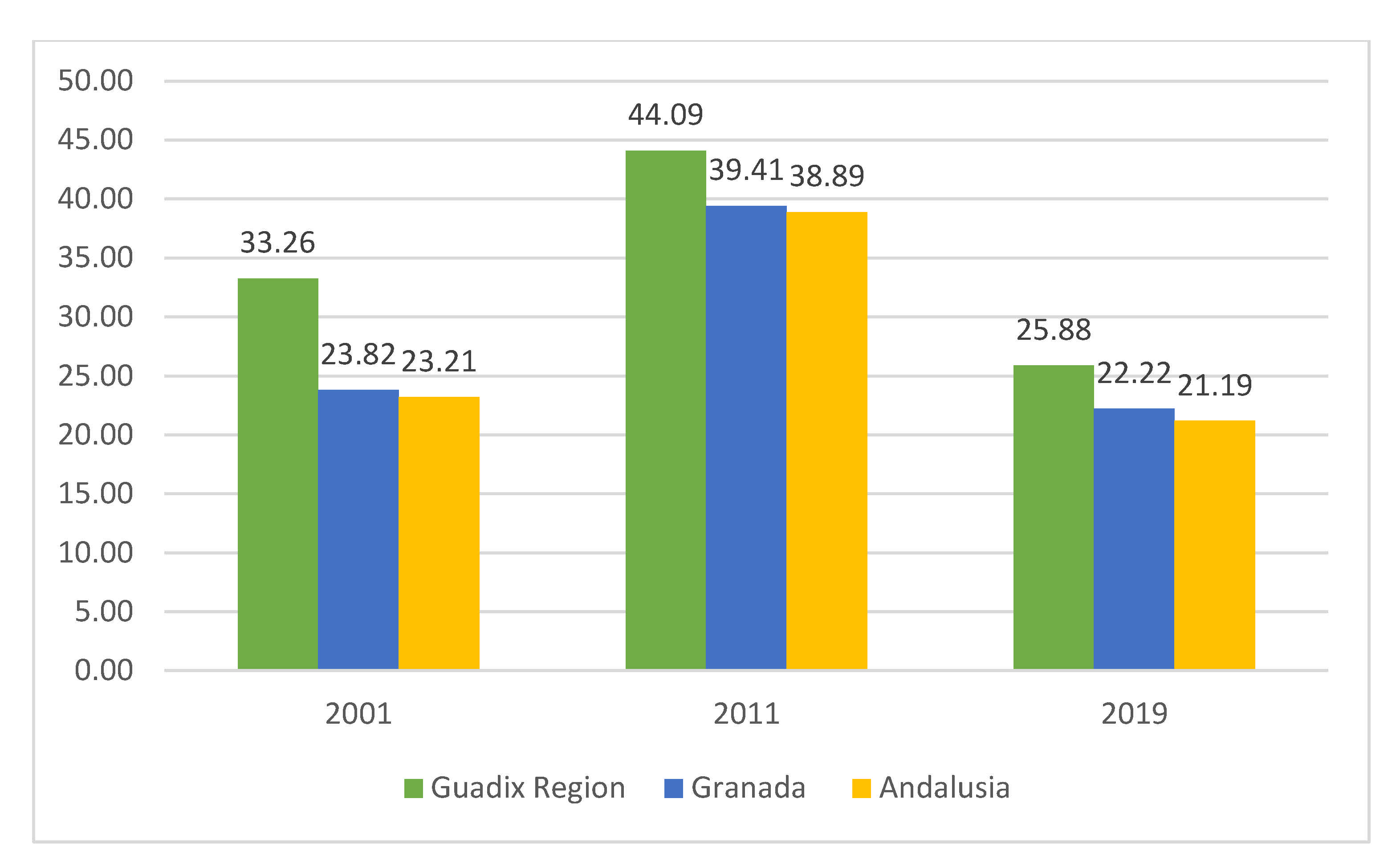
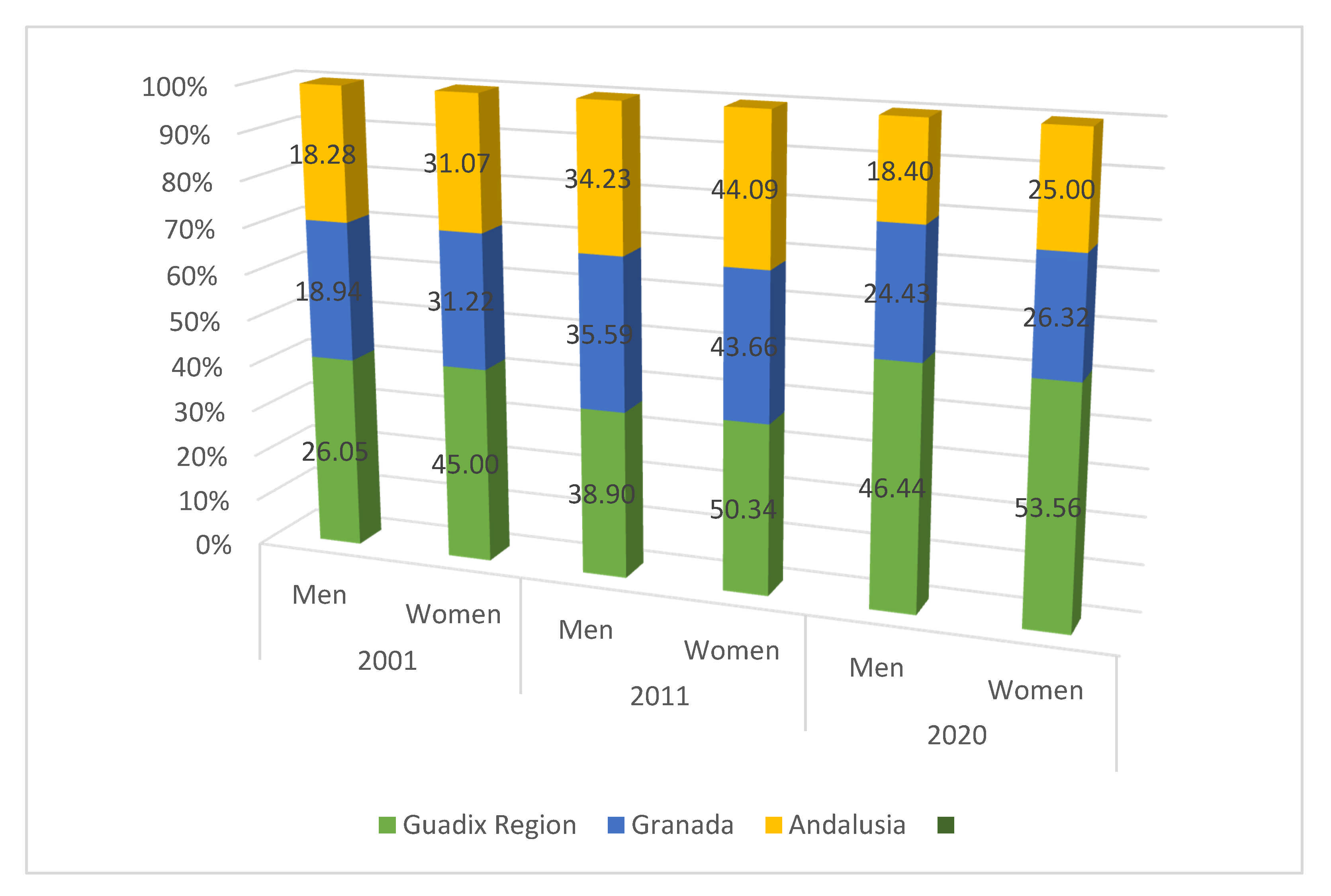
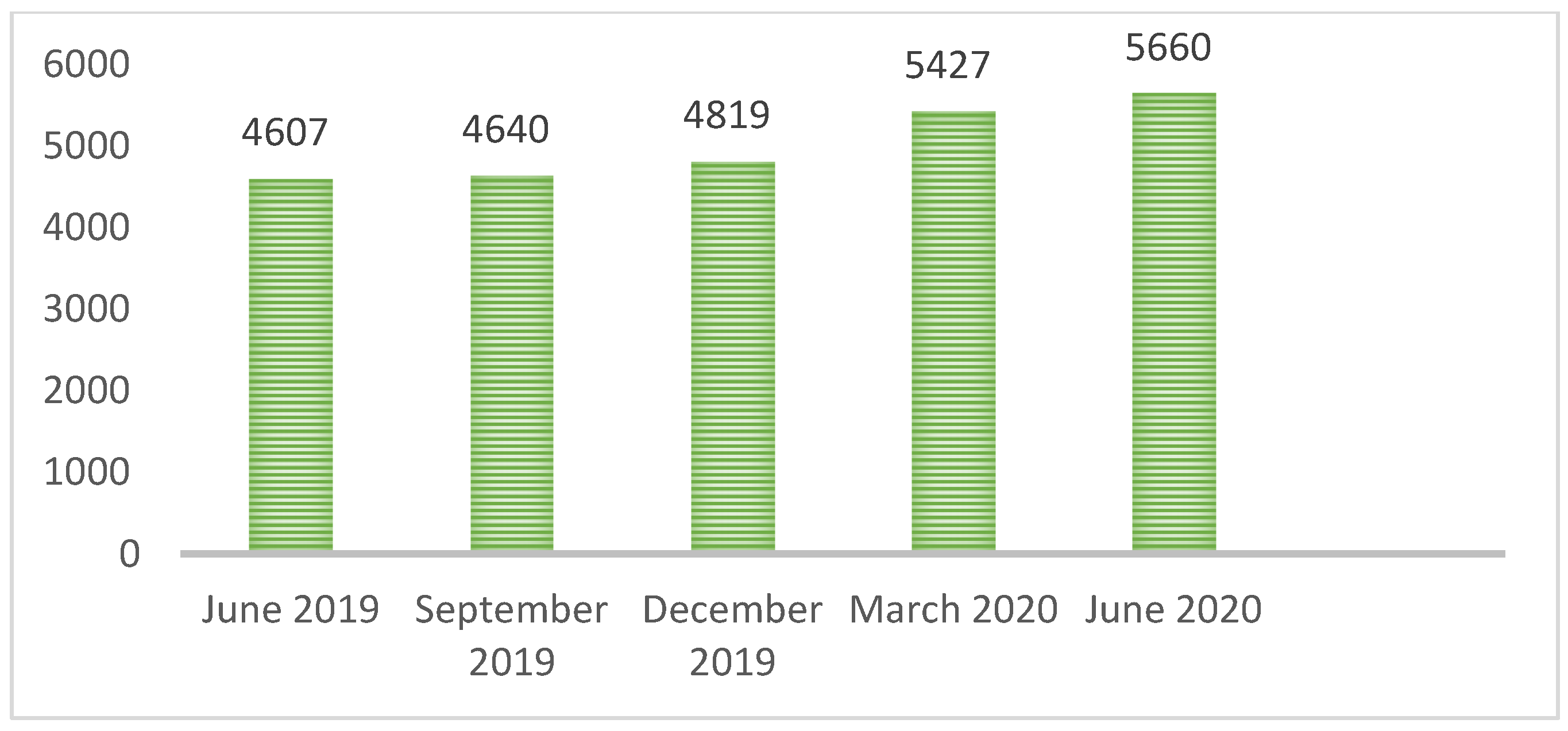
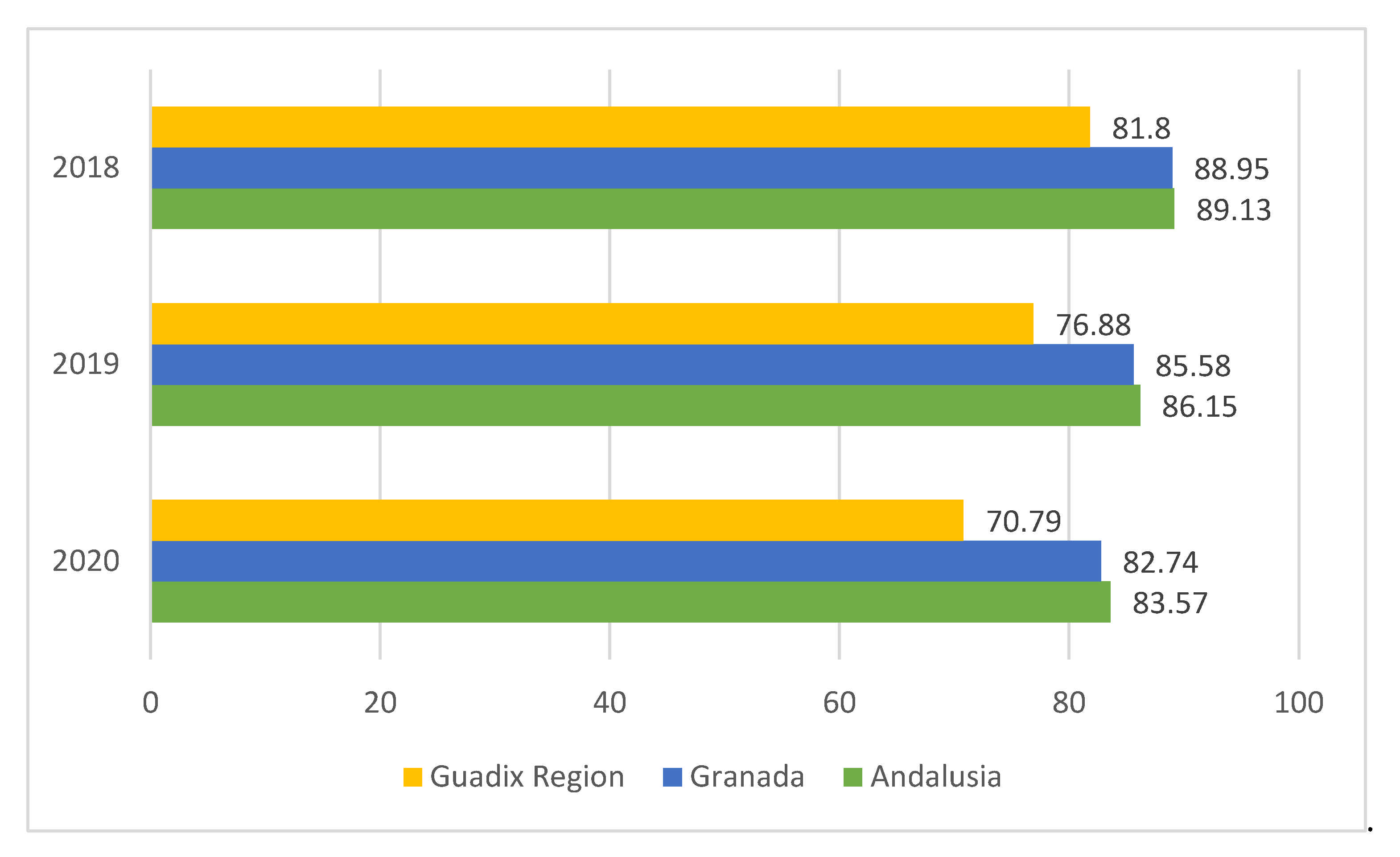
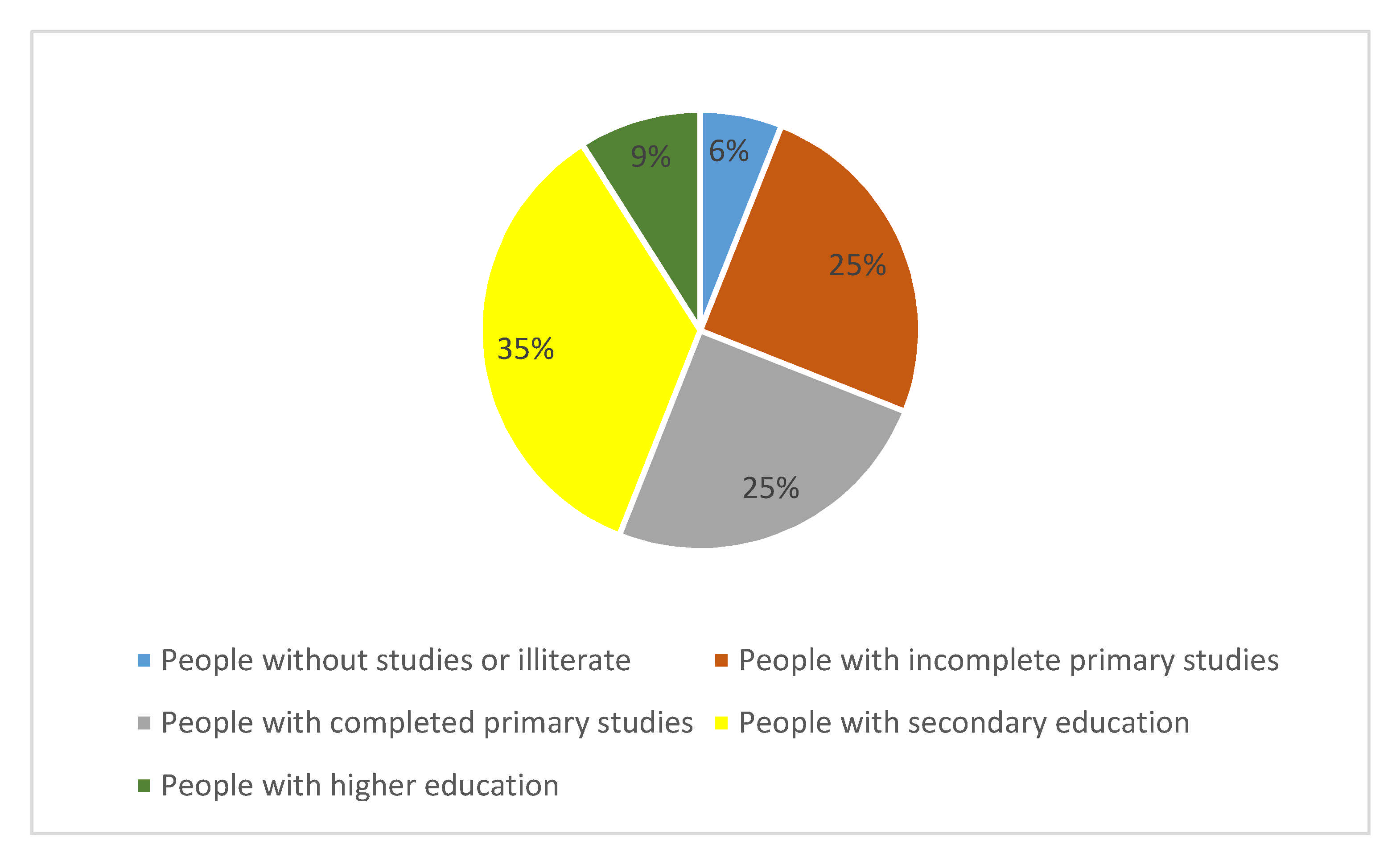
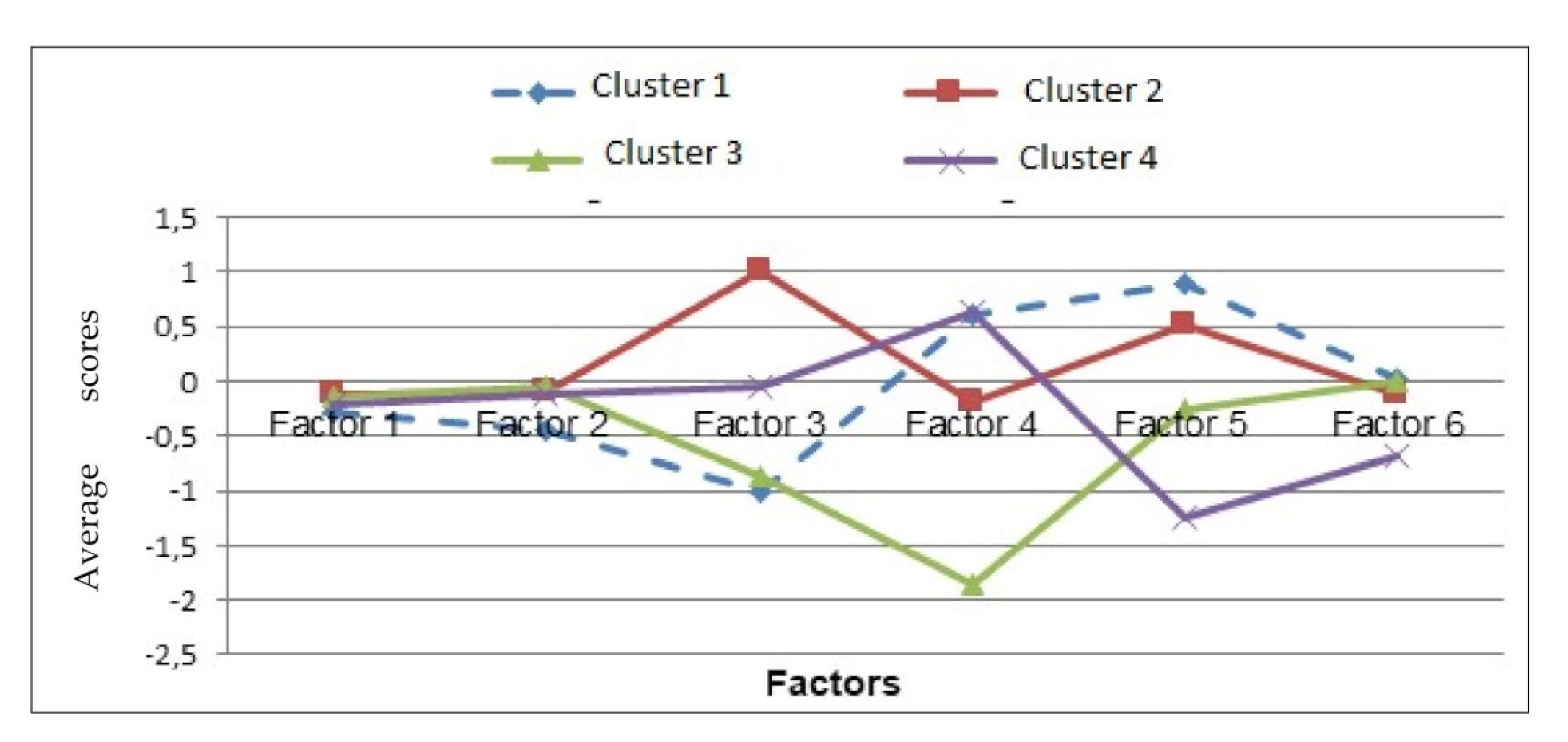
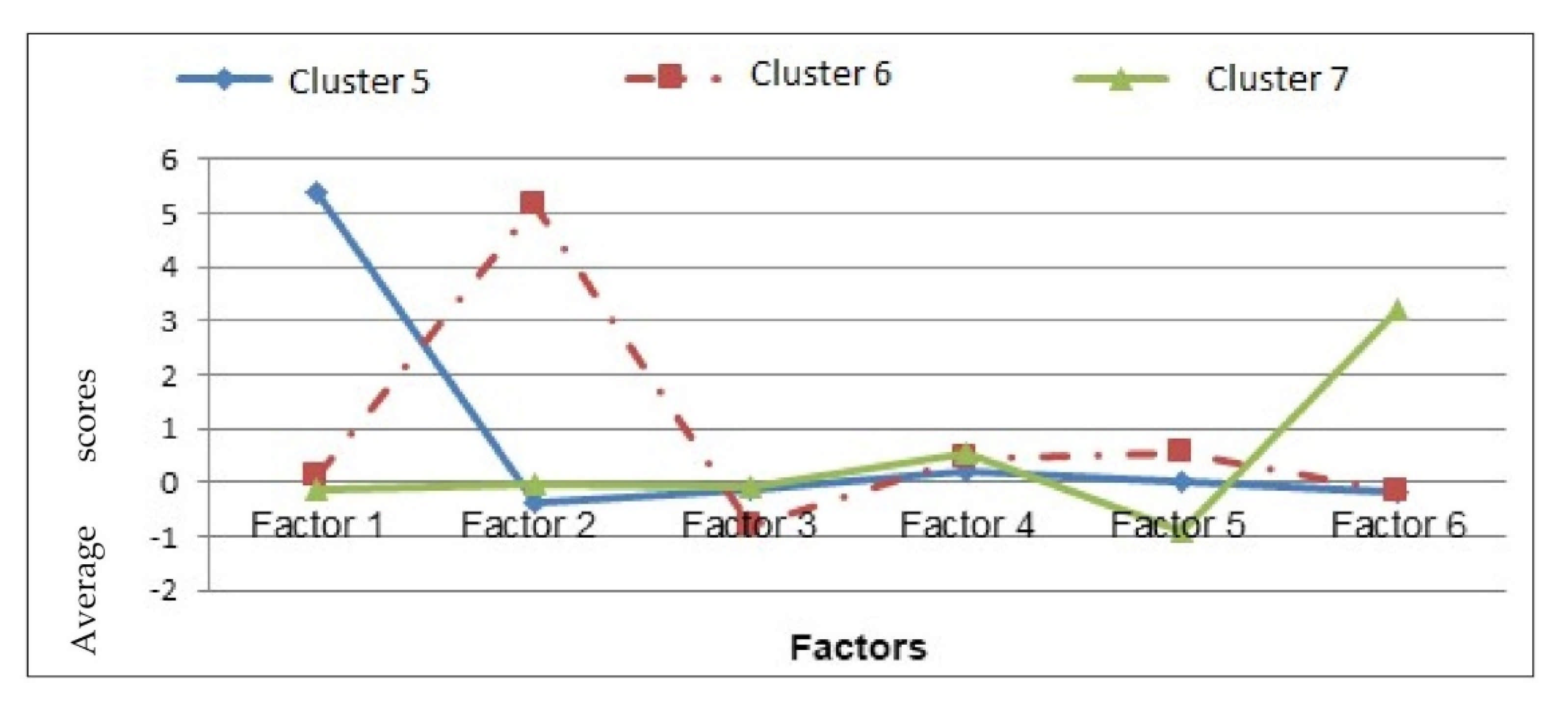
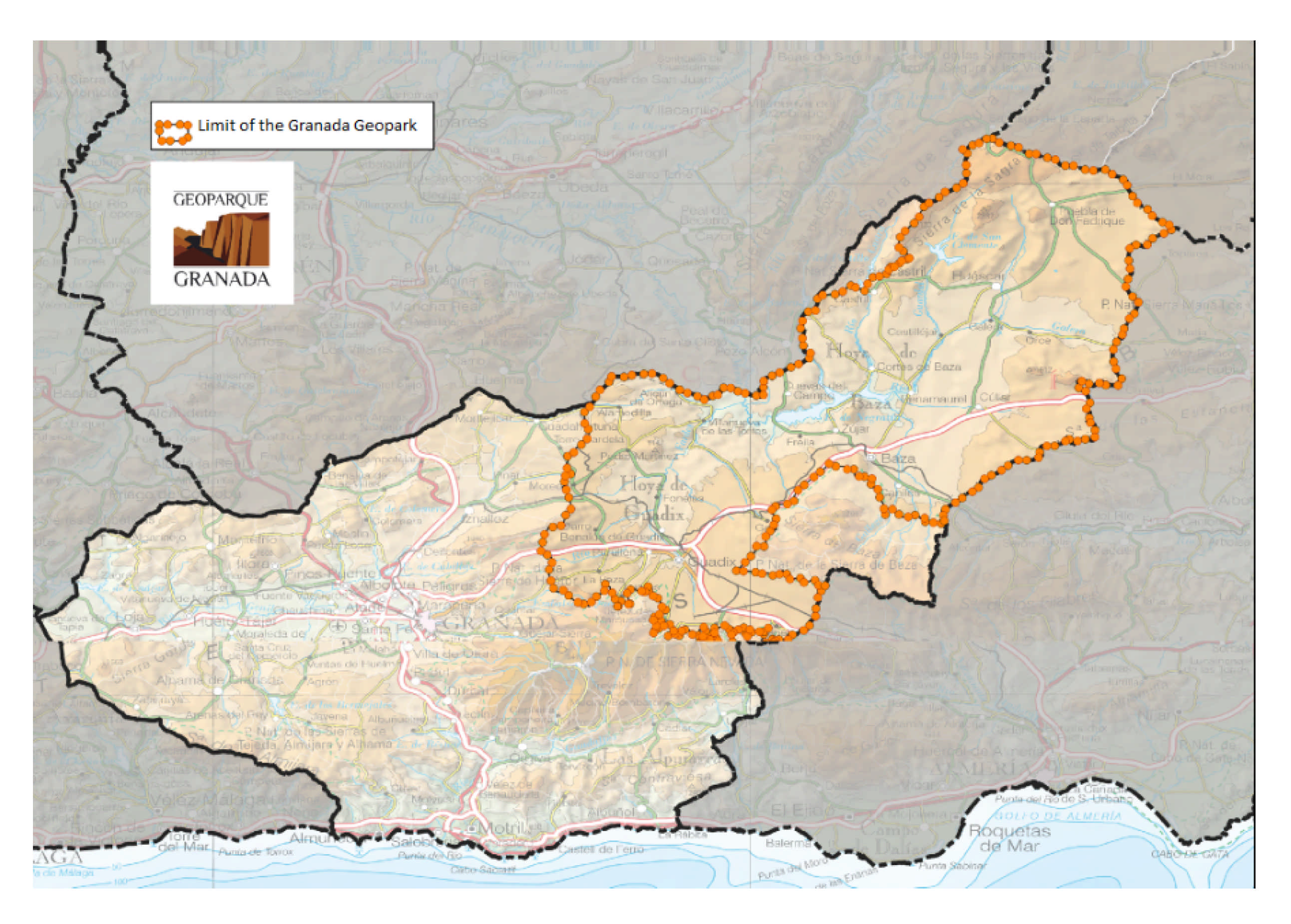
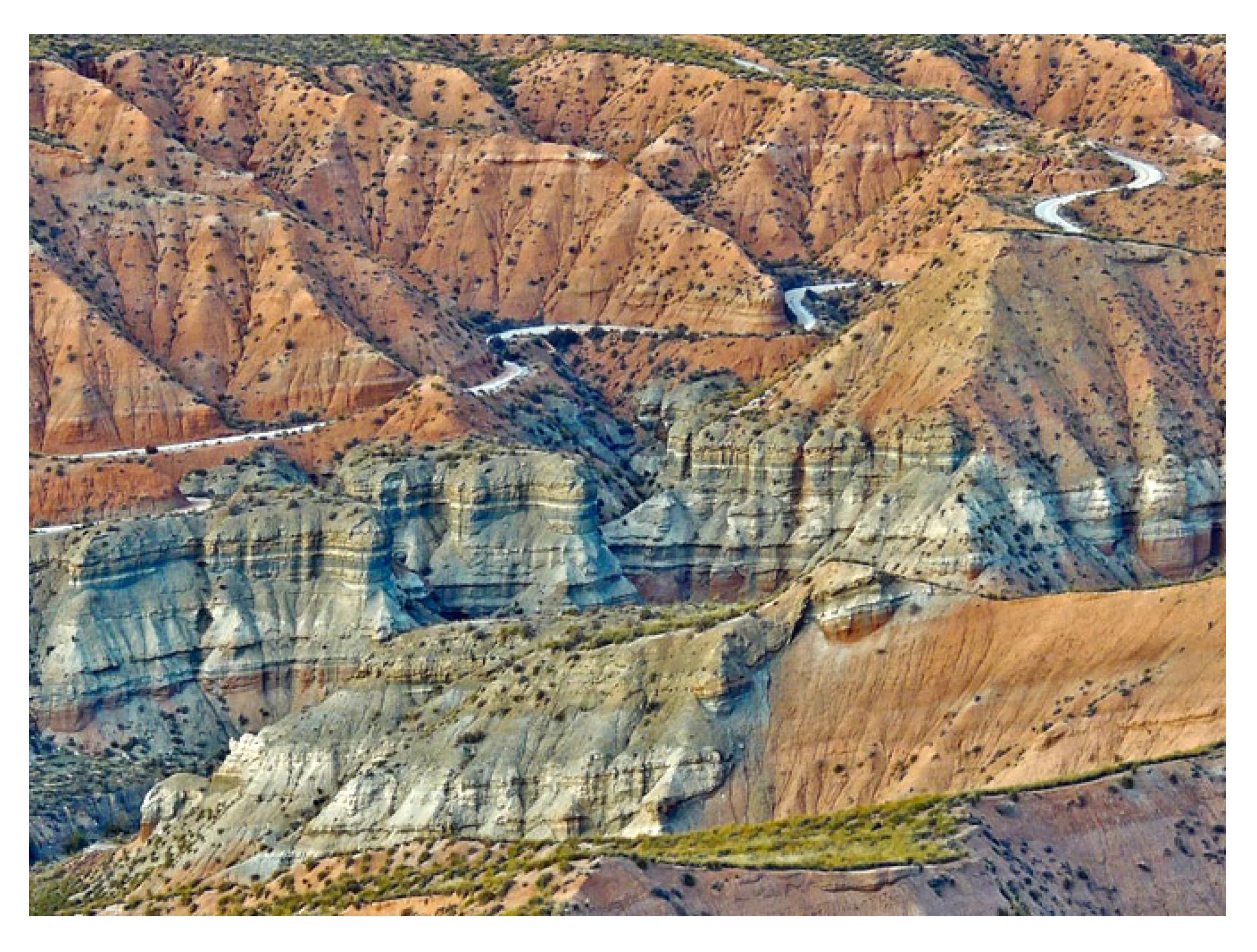
| Recorded Illiteracy Rate | Income from Business Activities per Inhabitant Recoded | Total | ||||
|---|---|---|---|---|---|---|
| Up to EUR 147 | EUR 148–231 | EUR 232–305 | EUR More than 306 | |||
| Less than 4% | % | 50.0% | 14.3% | 22.2% | 12.5% | 25.0% |
| 4–6% | % | 25.0% | 57.1% | 33.3% | 25.0% | 34.4% |
| More than 6% | % | 25.0% | 28.6% | 44.4% | 62.5% | 40.6% |
| Total | % | 100.0% | 100.0% | 100.0% | 100.0% | 100.0% |
| Type of Protected Resource | Name of the Protected Natural Area (PNA) | Municipality | Extension in Hectares of the PNA | % of Municipal Area Occupied by the Protected Resource | % of the PNA |
|---|---|---|---|---|---|
| Natural monument | Cárcavas de Marchal | Marchal | 5.22 | 0.67 | 100 |
| National Park | Sierra Nevada | Aldeire | 2553 | 36.43 | 2.99 |
| Dólar | 791 | 9.56 | 0.87 | ||
| Ferreira | 922 | 19.43 | 0.98 | ||
| Huéneja | 1785 | 14.48 | 1.96 | ||
| Jerez del Marquesado | 4941 | 62.59 | 6.01 | ||
| Lanteira | 2767 | 51.24 | 3.14 | ||
| Lugros | 2094 | 33.17 | 0.44 | ||
| Natural Park | Sierra de Huétor | Diezma | 412 | 9.87 | 3.4 |
| Sierra de Baza | Dólar | 2934 | 26.27 | 3.81 | |
| Gor | 8498 | 46.98 | 15.84 | ||
| Valle del Zalabí | 5896 | 54.88 | 10.99 | ||
| Sierra Nevada | Aldeire | 2072 | 59.68 | 2.42 | |
| Cogollos de Guadix | 711 | 47.36 | 0.83 | ||
| Dólar | 2934 | 23.05 | 1.04 | ||
| Ferreira | 882 | 40.97 | 1.03 | ||
| Huéneja | 1259 | 21.78 | 1.47 | ||
| Jerez del Marquesado | 3408 | 82.83 | 3.98 | ||
| La Calahorra | 77 | 4.27 | 0.09 | ||
| Lateira | 1918 | 72.87 | 2.24 | ||
| Lugros | 2731 | 86.78 | 3.19 |
Publisher’s Note: MDPI stays neutral with regard to jurisdictional claims in published maps and institutional affiliations. |
© 2021 by the authors. Licensee MDPI, Basel, Switzerland. This article is an open access article distributed under the terms and conditions of the Creative Commons Attribution (CC BY) license (http://creativecommons.org/licenses/by/4.0/).
Share and Cite
Álvarez-Lorente, T.; Entrena-Durán, F. Potential for Sustainable Development in the Southeastern Spanish Region of Guadix. Sustainability 2021, 13, 727. https://doi.org/10.3390/su13020727
Álvarez-Lorente T, Entrena-Durán F. Potential for Sustainable Development in the Southeastern Spanish Region of Guadix. Sustainability. 2021; 13(2):727. https://doi.org/10.3390/su13020727
Chicago/Turabian StyleÁlvarez-Lorente, Tamara, and Francisco Entrena-Durán. 2021. "Potential for Sustainable Development in the Southeastern Spanish Region of Guadix" Sustainability 13, no. 2: 727. https://doi.org/10.3390/su13020727
APA StyleÁlvarez-Lorente, T., & Entrena-Durán, F. (2021). Potential for Sustainable Development in the Southeastern Spanish Region of Guadix. Sustainability, 13(2), 727. https://doi.org/10.3390/su13020727






